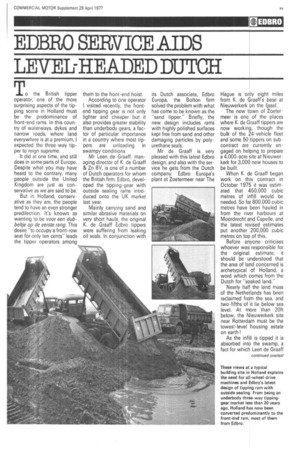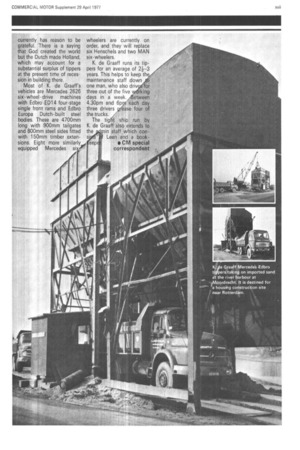EDBRO SERVICE AIDS LEVEL—HEADED DUTCH
Page 169

Page 171

If you've noticed an error in this article please click here to report it so we can fix it.
To the British tipper operator, one of the more surprising aspects of the tipping scene in Holland must be the predominance of front-end rams. In this country of waterways, dykes and narrow roads, where land everywhere is at a premium, I expected the three-way tipper to reign supreme.
It did at one time, and still does in some parts of Europe. Despite what you may have heard to the contrary, many people outside the United Kingdom are just as conservative as we are said to be.
But in Holland, conservative as they are, the people tend to have an even stronger predilection. It's known as wanting to be voor een dubbeltje op de eerste rang. This desire "to occupy a front-row seat for only ten cents" leads the tipper operators among
them to the front-end hoist.
According to one operator I visited recently, the frontend tipping gear is not only lighter and cheaper but it also provides greater stability than underbody gears, a factor of particular importance in a country where most tippers are unloading in swampy conditions.
Mr Leen de Graaff, managing director of K. de Graaff & Zn BV, is one of a number of Dutch operators for whom the British firm, Edbro, developed the tipping-gear with outside sealing rams introduced onto the UK market last year.
Mainly carrying sand and similar abrasive materials on very short hauls, the original K. de Graaff Edbro tippers were suffering from leaking oil seals. In conjunction with its Dutch associate, Edbro Europa, the Bolton firm solved the problem with what has come to be known as the "sand tipper." Briefly, the new design includes rams with highly polished surfaces kept free from sand and other damaging particles by polyurethane seals.
Mr de Graaff is very pleased with this latest Edbro design, and also with the service he gets from the Dutch company. Edbro Europa's plant at Zoetermeer near The Hague is only eight miles from K. de Graaff's base at Nieuwerkerk on the Ijssel.
The new town of Zoetermeer is one of the places where K. de Graaff tippers are now working, though the bulk of the 24-vehicle fleet and some 50 tippers on subcontract are currently engaged on helping to prepare a 4,000-acre site at Nieuwerkerk for 3,000 new houses to be built.
When K. de Graaff began work on this contract in October 1975 it was estimated that 450,000 cubic metres of infill would be needed. So far 800,000 cubic metres have been hauled in from the river harbours at Moordrecht and CapeIle, and the latest revised estimates put another 200,000 cubic metres on top of this.
Before anyone criticises whoever was responsible for the original estimate, it should be understood that the area of land concerned is archetypical of Holland, a word which comes from the Dutch for "soaked land."
Nearly half the land mass of the Netherlands has been reclaimed from the sea, and two-fifths of it lie below sea level. At more than 20ft below, the Nieuwerkerk site near Rotterdam must be the lowest-level housing estate on earth !
As the infill is tipped it is absorbed into the swamp, a fact for which Leen de Graaff currently has reason to be grateful. There is a saying that God created the world but the Dutch made Holland, which may account for a substantial surplus of tippers at the present time of reces sion in building there.
Most of K. de Graaff's vehicles are Mercedes 2626
six-wheel-drive machines with Edbro ED14 four-stage single front rams and Edbro Europa Dutch-built steel bodies. These are 4700rrin-i long with 900mm tailgates and 800mnrt steel sides fitted with 150mm timber extensions. Eight more similarly...0 equipped Mercedes si wheelers are currently on order, and they will replace six Henschels and two MAN six -wheelers. K. de Graaff runs its tippers for an average of 2-3 years. This helps to keep the, maintenance staff down ,t6 one man, who also driveefor three out of the five wO'rking days in a week -Setweerr 4.30prn and 6pril each day three drivers grease four of the trucks.
The tight ship run by K. de Graaff also extends to
the in staff...which conLeen -and a book*CM special correspondent




















































































































































































